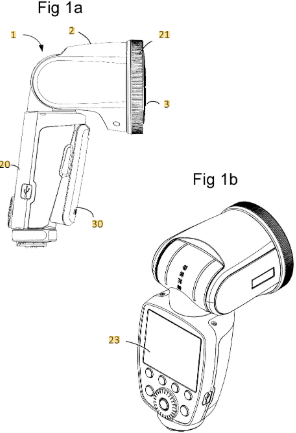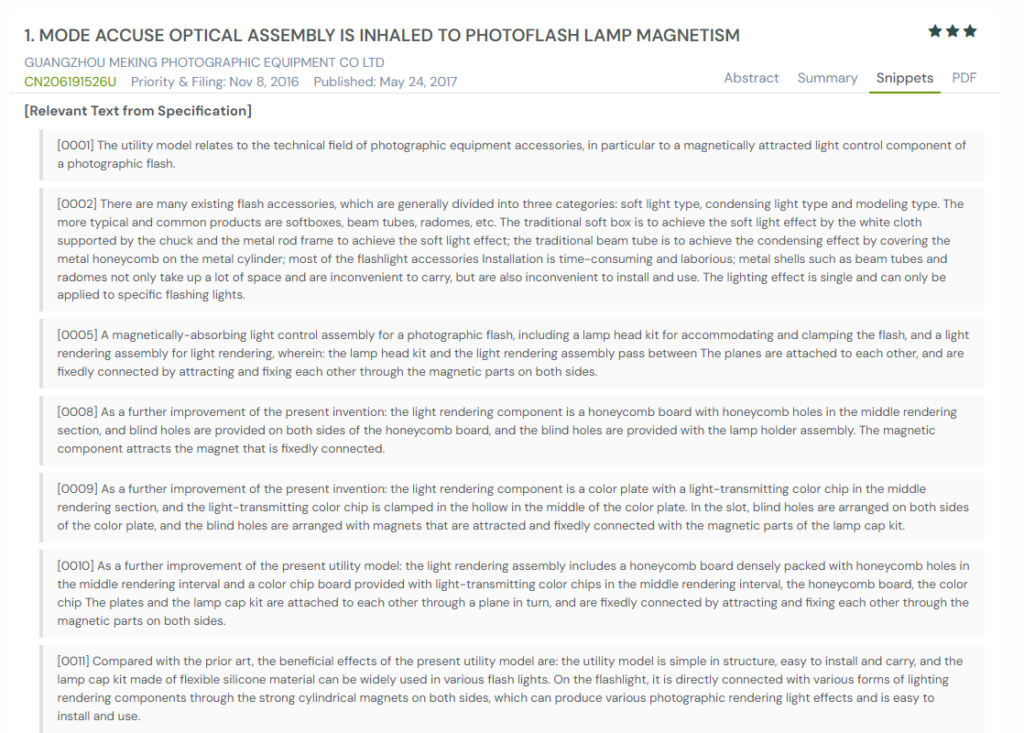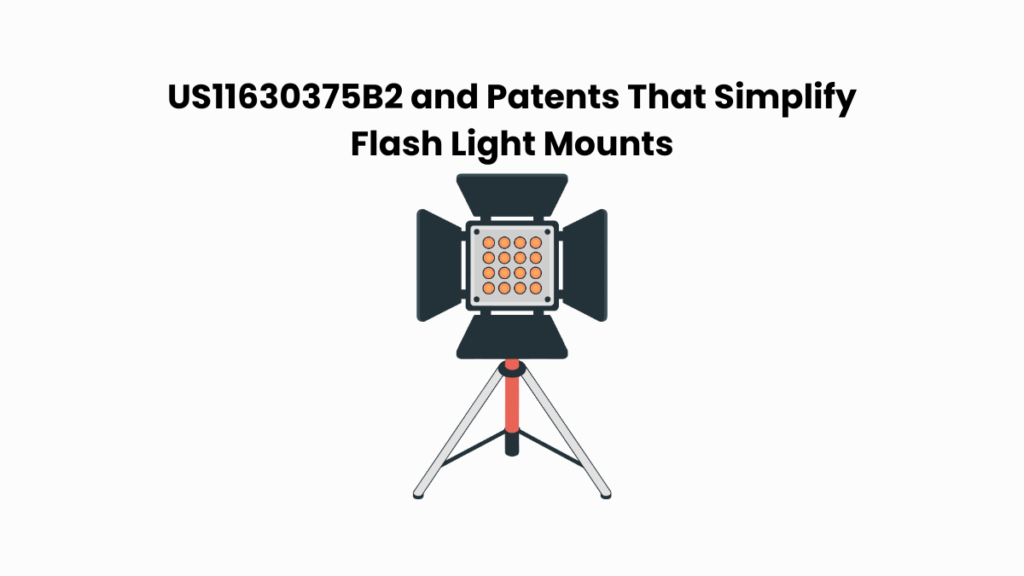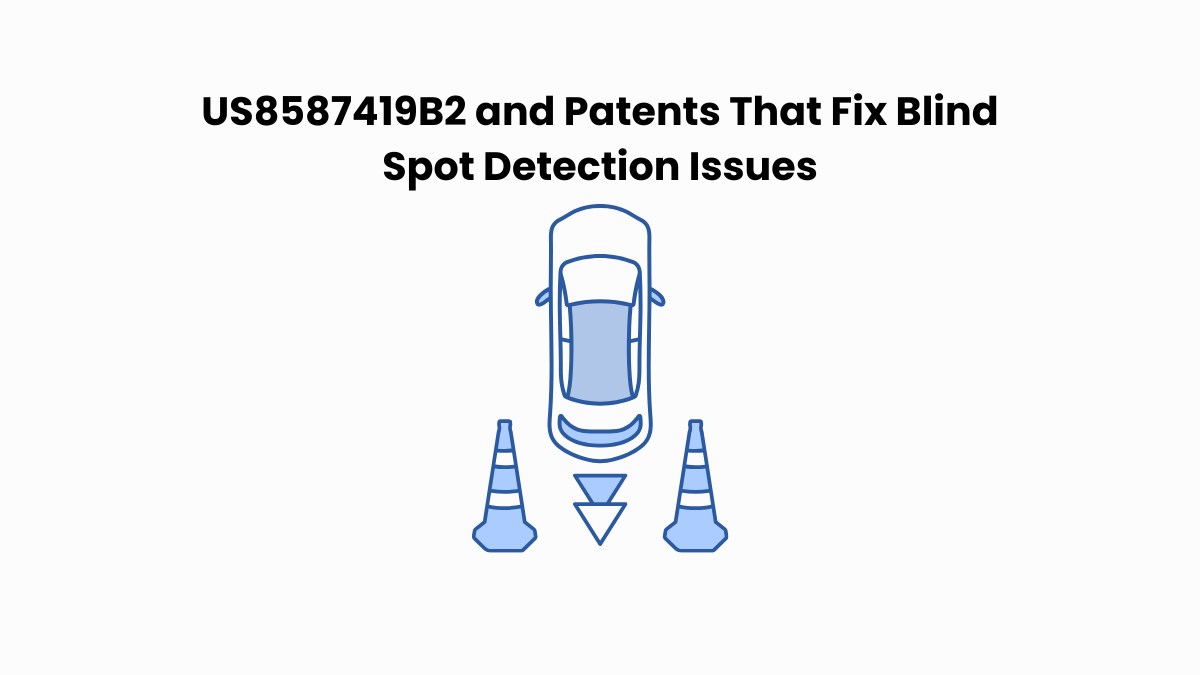Photographers rely on flash accessories, including diffusers, filters, and grids, to shape the light. Yet attaching them has often been slow and unreliable. Clips and mounts can loosen or waste precious seconds, especially during live shoots.
US11630375B2 introduces a smarter approach. It describes a flash housing with a magnetic fastening system built into the lens border, allowing accessories to snap into place instantly. Multiple tools can even be stacked for creative control.
The patent is currently a part of a litigation suit between Godox Photo Equipment Co., Ltd. and Profoto Aktiebolag. However, our focus here is not on the legal dispute, but rather on the technology landscape itself.
Using the Global Patent Search (GPS) tool, we will also explore five similar patents that address the same challenge in different ways. Some rely on silicone holders or magnetic frames. Others use rare-earth systems or are designed for industrial cameras. Together, they show the shift from clunky mounts to faster, magnet-driven designs.
Understanding Patent US11630375B2
US11630375B2 introduces a flash housing system designed for photographers who use light-shaping tools. The core idea is to simplify the attachment of these tools to the flash unit. Instead of using clips or manual mounts, the design relies on magnetic engagement to make the process quick and secure.

Source: Google Patents
The Key Features Of This Patent Are
1. Magnetic Mounting System
A fastening element lines the lens border, allowing tools to snap on magnetically.
2. Circular Lens Design
The flash lens has a round cross-section to support uniform light output and a magnetic fit.
3. Ferromagnetic Ring Structure
The fastening element is a ring made from ferromagnetic material for a strong magnetic pull.
4. Forward-Facing Mounting Surface
The magnetic surface faces forward, aligning with the flash’s direction for easy tool placement.
5. Zoom Control Integration
A zoom ring surrounds the lens and adjusts internal flash components through manual rotation.
6. Stackable Light Shaping Tools
Multiple tools can be stacked using magnets to create a combination of lighting effects.
7. Tool-to-Tool Magnetic Engagement
Each tool includes magnets on both sides, allowing one tool to attach to another.
8. Interchangeable Light Shaping Elements
Tools may hold diffusers, bounce cards, filters, or lenses that can be swapped and repositioned.
This patent focuses on user-friendly design and flexibility. It simplifies the lighting workflow for photographers through fast, secure magnetic attachments.
Related Read: Discover how US7609961B2 and similar patents use integrated camera systems embedded within light housings to improve imaging in dynamic environments.
Similar Patents To US11630375B2
To explore the design innovations behind US11630375B2, we used the Global Patent Search tool to identify similar patents. These references also aim to simplify how flash accessories attach to lighting equipment. While each takes a different approach, they all focus on ease of use, modularity, and flexible lighting control.
1. CN206191526U
This Chinese patent, CN206191526U, published in May 2017, introduces a magnetically connected light control system for photographic flash units. It replaces traditional mechanical mounts with flexible silicone holders and magnetic fasteners. The goal is to make flash accessories quicker to install and easier to carry while offering more creative lighting options.
Below, we have added snapshots from the GPS tool displaying the relevant sections from similar patents.

What This Patent Introduces To The Landscape
- A magnetic mounting system that connects light modifiers to flash units using strong cylindrical magnets
- A flexible silicone lamp holder that adapts to different types of flash devices
- Modular light shaping tools, such as honeycomb boards and color filters
- Honeycomb boards with blind holes that hold embedded magnets for secure attachment
- Color plates that include swappable light-transmitting color chips for different effects
- Components that stack together magnetically to produce layered lighting setups
- A tool-free system that simplifies the installation and removal of flash accessories
- A compact and lightweight structure that is easy to transport and use on location
How It Connects To US11630375B2
- Both patents use magnetic fastening to attach flash light shaping tools securely and quickly
- Each offers modular components that can be swapped or stacked based on lighting needs
- CN206191526U uses a silicone-based holder, while US11630375B2 uses a ring-shaped ferromagnetic mount
- Both focus on improving usability and speed for professional photographers
- Each enables customized lighting effects without requiring tools or permanent attachments
Why This Matters
CN206191526U delivers a flexible and portable flash accessory system powered by magnetism. Like US11630375B2, it simplifies how photographers modify light during a shoot. Its modular, tool-free design offers an alternative approach to solving the same challenge: making lighting faster to shape and easier to control.
2. WO2012038726A1
This international patent, WO2012038726A1, published in March 2012, introduces a modular light modification system for flash photography. It replaces traditional adhesive or hook-and-loop mounting with magnetic fasteners. The invention enables secure, repeatable attachment of gels, diffusers, and grids through a layered frame system.
What This Patent Introduces To The Landscape
- A modular lighting system with light-modifying elements that attach magnetically to a support frame
- Use of permanent magnets on both front and rear faces of the frame components
- A base frame that connects to multiple light-modifying accessories, such as gels, grids, or barn doors
- Sheet-receiving elements with built-in magnets for snap-fit alignment with the base frame
- Raised platforms with central magnets and positioning features like projections and recesses
- Mechanical alignment features that prevent sideways movement and ensure accurate positioning
- Stackable components for layered lighting control, including diffusers and honeycomb inserts
- A kit-based design that allows the user to combine accessories for customized light effects
How It Connects To US11630375B2
- Both inventions use magnetic fasteners to attach lighting tools to a flash unit
- Each system supports modular stacking of light shaping elements like gels or grids
- WO2012038726A1 uses a frame-based structure, while US11630375B2 features a ring-mounted magnetic housing
- Both aim to eliminate mechanical fasteners and reduce setup time for photographers
- Each design allows multiple accessories to be layered without tools or permanent modification
Why This Matters
WO2012038726A1 shows how magnet-based frames can streamline flash accessory use. Like US11630375B2, it focuses on fast, tool-free attachment and modularity. By using aligned magnets and mechanical guides, it offers a secure, customizable platform for controlling flash light with precision and speed.
3. GB2448508A
This UK patent, GB2448508A, published in October 2008, introduces a magnetic mounting method for attaching lighting accessories. Designed for film, television, and photography applications, the system allows modifiers like filters, gobos, and barn doors to snap onto lighting fixtures using aligned magnets. It also supports stacking multiple accessories in the optical path.

What This Patent Introduces To The Landscape
- A magnetic system for attaching light modifiers directly to luminaires
- Use of rare-earth magnets (e.g., neodymium) for strong, reliable attachment
- Compatible with various accessories, including filters, gobos, diffusers, and lens frames
- Magnetic poles oriented to allow stacking of multiple lighting tools
- Applicable to studio or location lighting setups for film and photography
- Eliminates traditional mechanical mounts or clamps
- Supports modular combinations in the optical path for layered effects
- Enables fast installation and removal of accessories without tools
How It Connects To US11630375B2
- Both patents use magnets to attach and stack light-shaping accessories
- Each supports tool-free installation for a faster workflow
- GB2448508A targets a broader lighting fixture category, while US11630375B2 focuses on flash housing
- Both aim to improve versatility and portability for professional photographers or filmmakers
- Magnetic polarity alignment is used in both to enable secure multi-layer configurations
Why This Matters
GB2448508A offers a flexible magnetic attachment method suited for complex lighting setups. Like US11630375B2, it replaces clunky mechanical fixtures with simple, magnetic connections. This approach supports faster adjustments and broader accessory compatibility, key benefits in high-paced photo and video environments.
4. US5708874A
This U.S. patent, US5708874A, published in January 1998, introduces a magnetic system for attaching a flash unit directly to a camera. The design allows the flash to rotate into multiple docked positions and provides a secure magnetic lock without mechanical fasteners. It also includes shielding components to control when and how the magnetic connection is activated.
What This Patent Introduces To The Landscape
- A magnetic mounting method to attach a flash unit directly to a camera
- Rotatable shielding plates that expose or block the magnetic field as needed
- Secure alignment using key-and-slot connections to guide rotation and locking
- Rare-earth magnets (e.g., neodymium) for a strong holding force
- Multiple docked positions allowing bounce flash angles
- A sealed connection that protects against water, dust, and debris
- Compatibility with infrared-triggered flash systems reducing the need for mechanical links
- An internal structure that supports multiple magnet sets for advanced positioning options
How It Connects To US11630375B2
- Both systems use magnet-based attachment instead of mechanical clips or fasteners
- Each allows non-permanent, tool-free connections to simplify the user workflow
- US5708874A focuses on attaching entire flash units, while US11630375B2 attaches light shaping tools
- Both designs improve precision and ease of use with rotational or alignment features
- Each supports fast mounting and demounting, critical for dynamic photography environments
Why This Matters
US5708874A presents a magnetic flash mounting system that prioritizes secure attachment, flexibility, and speed. While US11630375B2 applies similar principles to modular accessories, both aim to eliminate clunky mechanical parts and improve the user experience in photography settings that demand speed and adaptability.
5. US2014098225A1
This U.S. patent, US2014098225A1, published in April 2014, introduces a magnetic attachment system for optical accessories used in machine vision cameras. It allows components like supplemental lenses and illumination modules to snap onto a camera using magnetic force. This enables fast setup, electrical connectivity, and secure alignment, especially in hard-to-reach environments.

What This Patent Introduces To The Landscape
- A magnetic mounting system for supplemental lenses and illumination modules in machine vision setups
- Mounting elements with embedded magnets that attach directly to a camera housing
- Magnetic retention forces strong enough to hold accessories securely during use
- Electrical connectors integrated into the mounting system for automatic power and control
- Configurations that allow accessories to rotate about the camera axis after attachment
- Alignment features (e.g., magnet polarity or custom spacing) to enforce correct orientation
- Quick installation and removal, especially useful for tight or obstructed camera setups
- Modular stacking of multiple accessories using magnet-to-magnet or magnet-to-metal contact
- Use of rare-earth magnets, such as neodymium, for strong, reliable retention
- Dual-function mounts combining magnetic coupling and electrical contact in a single action
How It Connects To US11630375B2
- Both use magnetic components to attach accessories to optical systems quickly and without tools
- US2014098225A1 focuses on machine vision cameras, while US11630375B2 targets photographic flash units
- Each supports modular accessory design and layered attachments
- US11630375B2 prioritizes creative light shaping; US2014098225A1 emphasizes automation and industrial use
- Both allow for easy detachment and reattachment without damaging the core device
Why This Matters
US2014098225A1 brings a highly engineered, magnet-based approach to camera accessory management. Although it is tailored for industrial vision systems, the principles of fast attachment, secure locking, and modular flexibility closely align with those in US11630375B2. It reinforces the value of magnetics in modern optical design, whether for a studio shoot or an assembly line inspection.
Related Read: See how US9498889B1 focuses on stability in knife mechanisms, much like flashlight mount patents that ensure steadiness during use.
How To Find Related Patents Using Global Patent Search
Understanding the ecosystem around flash lighting accessories is essential when designing fast, flexible, and tool-free attachment systems. The Global Patent Search tool helps uncover similar patents that solve comparable challenges in magnetic mounting and modular light control. It also helps to avoid potential infringement by showing how others have claimed similar technologies.

- Enter the patent number: Start by entering a patent like US11630375B2 into the GPS tool. Use keywords such as “magnetic mount,” “flash accessory,” or “light shaping tool” to refine the search.
- Review curated snippets: Instead of full claims, GPS now displays targeted excerpts. These highlight how other systems use magnets, rings, or alignment features to secure flash tools or optical components.
- Find related technologies: GPS helps identify other patents focused on lighting modifiers, stacking accessories, or magnet-based attachments for photography, film, or machine vision.
- Compare design approaches: Rather than mapping claims, GPS shows how others achieve fast attachment, precise positioning, or modular stacking using different mechanisms or materials.
- Explore across applications: The tool links innovations from diverse fields like studio lighting, industrial imaging, or mobile flash systems, helping you see the broader trend toward magnetic and modular design.
Global Patent Search empowers inventors, engineers, and legal professionals to quickly uncover technical insights and competitive approaches. It’s also a powerful way to strengthen your patent portfolio by identifying gaps, avoiding duplication, and spotting emerging design trends early.
Want to accelerate your search process? Learn practical tips to navigate Global Patent Search faster and uncover relevant magnetic mounting patents in less time.
Disclaimer: The information provided in this article is for informational purposes only and should not be considered legal advice. The related patent references mentioned are preliminary results from the Global Patent Search tool and do not guarantee legal significance. For a comprehensive related patent analysis, we recommend conducting a detailed search using GPS or consulting a patent attorney.




